== EDIT: Here is a minimal example https://jsfiddle.net/hpb10ao2/2/ ==
When I use this code:
for (var x = 0; x < 50; x+=10) {
var obj = new window[type]();
obj.bounds.position = new Vector(x, 0);
console.log("RECT at " + obj.bounds.position);
objects.push(obj);
}
for (var i = 0; i < objects.length; i++)
console.log(objects[i].position());
where type is "Wall", which is an object with a "bounds" property that has a "position" property. It outputs this:
When I create walls using new Wall() multiple times, this doesn't happen, so it isn't a problem with that function, or any others I made (right?) Why is the position variable different after the loop?
Vector function: http://pastebin.com/4J7S6jbJ
function Vector(x, y) {
if (x === undefined)
x = 0;
if (y === undefined)
y = 0;
this.x = x;
this.y = y;
this.add = function(x, y) {
if (y === undefined)
y = x;
this.x += x;
this.y += y;
return this;
};
this.addVector = function(other) {
this.x += other.x;
this.y += other.y;
return this;
};
this.subtract = function(x, y) {
if (y === undefined)
y = x;
this.x -= x;
this.y -= y;
return this;
};
this.subtractVector = function(other) {
this.x -= other.x;
this.y -= other.y;
return this;
};
this.multiply = function(x, y) {
if (y === undefined)
y = x;
this.x *= x;
this.y *= y;
return this;
};
this.multiplyVector = function(other) {
this.x *= other.x;
this.y *= other.y;
return this;
};
this.divide = function(x, y) {
if (y === undefined)
y = x;
this.x /= x;
this.y /= y;
return this;
};
this.divideVector = function(other) {
this.x /= other.x;
this.y /= other.y;
return this;
};
this.magnitude = function() {
return Math.sqrt(this.x * this.x + this.y * this.y);
};
this.direction = function() {
return Math.atan(this.y / this.x);
};
this.distance = function(other) {
return Math.sqrt(Math.pow(this.x - other.x, 2) + Math.pow(this.y - other.y, 2));
};
this.crossProduct = function(other) {
return this.x * other.y - this.y * other.x;
};
this.normalize = function() {
if (this.x == 0 && this.y == 0) {}
else if (this.x == 0)
this.divide(1, this.magnitude());
else if (this.y == 0)
this.divide(this.magnitude(), 1);
else
this.divide(this.magnitude());
return this;
};
this.toString = function() {
return this.x + "," + this.y;
};
this.clone = function() {
return new Vector(this.x, this.y);
};
this.equals = function(other) {
return other.x == this.x && other.y == this.y;
};
}
